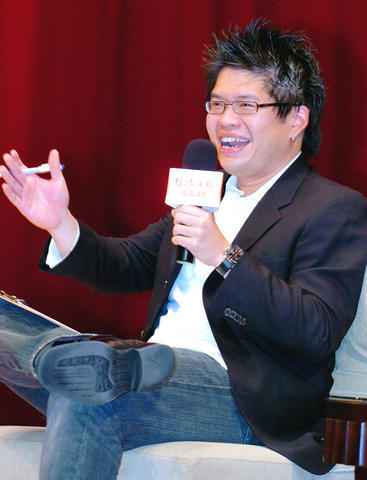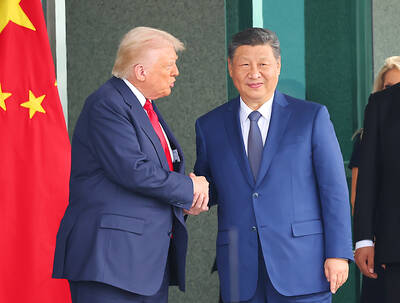In his first public speech in Taiwan, popular video-sharing site YouTube co-founder Steve Chen (
His speech attracted hundreds of local YouTube fans who were keen to pick the brain of one of the most prominent Internet hotshots.
Born in Taiwan, Chen, 29, moved to the US with his parents when he was eight years old.

PHOTO: LIAO CHEN-HUEI, TAIPEI TIMES
Wearing a white shirt and jeans, and sporting short, spiky hair and an earring in both ears, Chen ascribed YouTube's success to video being a cross-cultural communication tool "that can break the language barrier."
Chen created YouTube with his friends Chad Hurley and Jawed Karim to share video clips they had made during a gathering, he recalled.
Launched in February 2005 in Hurley's garage, YouTube has quickly accumulated high traffic volumes and became one of the world's most visited sites.
It was acquired by Internet titan Google Inc last October for US$1.65 billion.
With half of its users living outside the US, YouTube may develop different language versions for the site, including a Mandarin version for Taiwan, to boost its appeal to global users, he said.
Chen delivered the speech at a forum in Taipei which was also attended by other industry leaders, including Chunghwa Telecom Co (
Chen said the Internet was moving from the so-called Web 2.0 era -- user-generated content in a user-oriented environment -- to the Web. 3.0 era, in which users are no longer tied to their PCs, while enjoying much more personalized and individualized content and services on the go.
Going mobile
To follow the trend, YouTube will go mobile by the end of next year, allowing users to share video clips on handsets and mobile devices, he said.
The coming of the Web 3.0 era means more bandwidth, faster transmission speeds, and more content with more diversification to serve increasingly complicated user needs, Hochen said.
To achieve these goals, significant investment in infrastructure is needed, he said. While the nation's largest telecom company tries to build more base stations, it has met constant protests from local residents, he said.
Another obstacle is concerns over the relevant business models, Hochen said. Web 2.0 sites generate income mainly from advertising and subscription, which does not seem to ensure a return on investments in the short term, he said.
Kuei shrugged off the concern, saying that huge advertising revenues were ready to pour into Web 2.0 sites, as they could better target specific customer groups from different budget segments.
The total advertising budget in Taiwan last year was between NT$40 billion (US$1.21 billion) and NT$50 billion, which is more than many public companies' annual revenues, Kuei said.
One challenge the speakers seemed to agree on is piracy. In China, for example, there are already more than 200 video-sharing sites copying YouTube's business model.
But as long as YouTube can remain a destination offering the most content catering to a majority of users, users will stay with the site, Chen said.

Nissan Motor Co has agreed to sell its global headquarters in Yokohama for ¥97 billion (US$630 million) to a group sponsored by Taiwanese autoparts maker Minth Group (敏實集團), as the struggling automaker seeks to shore up its financial position. The acquisition is led by a special purchase company managed by KJR Management Ltd, a Japanese real-estate unit of private equity giant KKR & Co, people familiar with the matter said. KJR said it would act as asset manager together with Mizuho Real Estate Management Co. Nissan is undergoing a broad cost-cutting campaign by eliminating jobs and shuttering plants as it grapples

TEMPORARY TRUCE: China has made concessions to ease rare earth trade controls, among others, while Washington holds fire on a 100% tariff on all Chinese goods China is effectively suspending implementation of additional export controls on rare earth metals and terminating investigations targeting US companies in the semiconductor supply chain, the White House announced. The White House on Saturday issued a fact sheet outlining some details of the trade pact agreed to earlier in the week by US President Donald Trump and Chinese President Xi Jinping (習近平) that aimed to ease tensions between the world’s two largest economies. Under the deal, China is to issue general licenses valid for exports of rare earths, gallium, germanium, antimony and graphite “for the benefit of US end users and their suppliers

Dutch chipmaker Nexperia BV’s China unit yesterday said that it had established sufficient inventories of finished goods and works-in-progress, and that its supply chain remained secure and stable after its parent halted wafer supplies. The Dutch company suspended supplies of wafers to its Chinese assembly plant a week ago, calling it “a direct consequence of the local management’s recent failure to comply with the agreed contractual payment terms,” Reuters reported on Friday last week. Its China unit called Nexperia’s suspension “unilateral” and “extremely irresponsible,” adding that the Dutch parent’s claim about contractual payment was “misleading and highly deceptive,” according to a statement

The Chinese government has issued guidance requiring new data center projects that have received any state funds to only use domestically made artificial intelligence (AI) chips, two sources familiar with the matter told Reuters. In recent weeks, Chinese regulatory authorities have ordered such data centers that are less than 30 percent complete to remove all installed foreign chips, or cancel plans to purchase them, while projects in a more advanced stage would be decided on a case-by-case basis, the sources said. The move could represent one of China’s most aggressive steps yet to eliminate foreign technology from its critical infrastructure amid a